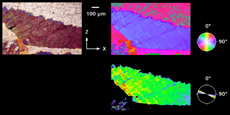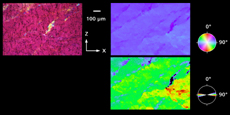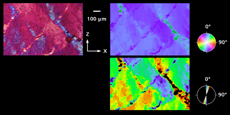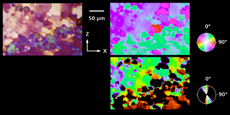5.3
ORIENTATION IMAGES OF NATURALLY DEFORMED ROCKS
top / contents / section 5 / pages -- 5.1 -- 5.2 -- 5.3 -- 5.4 -- 5.5 -- 5.6
Quartz veins from the Glarus thrust
(Mirjam van Daalen)

Four samples of syntectonic quartz veins were collected in the Verrucano in close proximity to the Glarus thrust. The veins are embedded in a metapelitic host rock. The sampling locations of sample A, B, C, and D correspond to temperatures of 270, 300, 350, and 370°C, respectively. Peak temperatures are constrained by careful illite crystallinity measurements. Typically, the quartz veins are oriented parallel or subparallel to the foliation. They consist of fibres which are less than one millimeter wide and a few millimeters long. Fibre long axes are oriented approximately parallel to the lineation direction.(more on page 6.4)
Orientation images of samples A, B, C, D: Each plate consist of the following parts:
Left: Optical micrograph: Crossed polarizers and lambda plate; foliation normal is vertical, lineation is horizontal; shear sense is top to the left, which is (geographic) North in each case. White cross is marker point which corresponds to red cross on orientation contrast image (4).
Top right: CIP derived C-axis orientation image (COI): Spectral CLUT is oriented such that the orientation of the c-axis of the host grain is represented by blue.
Bottom right: CIP derived C-axis orientation image (COI): Condensed CLUT is oriented such that the orientation of the c-axis of the host grain is represented by green.
Reference:
van Daalen, M., R. Heilbronner, et al. (1999). "Orientation analysis of localized shear deformation in quartz fibres at the brittle-ductile transition." Tectonophysics 303: 83-108.
van Daalen, M., PhD thesis, Dept. of Geosciences, Basel University (http://www.unibas.ch/earth/)


